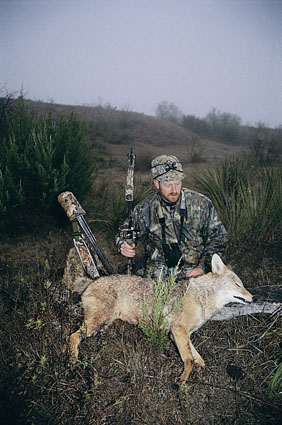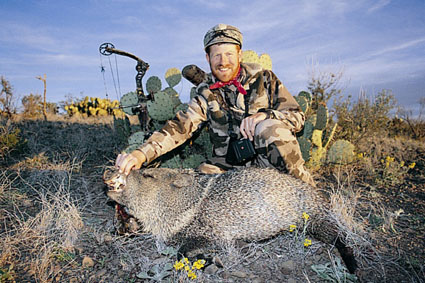 January-March: Coyotes can now be hunted almost anytime, anywhere, and taking a big dog like this is a huge favor to next spring’s fawn crop. |
Coyotes
Calling predators such as coyotes, bobcats or foxes is a sport that most hunters across the country can enjoy in their nearest woodlot, river bottom, or canyon. The first few months of the year are good because a predator’s limited winter food supply can make calling a deadly tactic. It’s also prime time because pelts are the thickest during the cold winter months.
High-strung, sneaky coyotes are one of bowhunting’s toughest trophies. They offer a very small target and seem to never stand still. I missed many shots at string-jumping coyotes over the years before finally punching an arrow through my first in the fall of 2000. By early 2001 I had arrowed two additional thick-furred ’yotes. I can honestly say I’m as proud of those three mature coyotes taken with archery tackle as any big buck.
I prefer to call with a partner, and we will take turns being caller and shooter. At each location we set up with the shooter about 10 or 20 yards downwind of the caller. Predators will almost always circle downwind before committing to a call. A slight height advantage, either by positioning yourself on a haystack or at the head of a ravine, makes it easier to spot incoming predators. Using a decoy like a stuffed animal, rabbit skin draped on a rock, or commercial foam decoy will help distract the coyote.
Drawing a bow undetected is the hardest part of this game, so time your draw when the coyote’s head goes behind a tree or bush. Call for about 30 minutes off and on from each location before changing spots.
Mouth calls of either a dying cottontail or wounded jackrabbit are standard gear. My current favorite is a hand-operated call that I can squeeze all day and my cheeks never get fatigued like with a mouth call. You can also stick a squeezable call under your knee and with the slightest movement create soft sounds to coax the predator to approach within bow range. This leaves both hands free to concentrate on the shot. Full camouflage, including gloves and a headnet, are important.
Javelinas
The afternoon light was fading as the tall prickly pear clumps around me cast long shadows across the rocky, dry ground of West Texas underfoot. My partner suddenly looked up from his binoculars with a wide grin and whispered, “Pigs, 200 yards down the hill. At least 10 of ’em!”
 January-February: Bust the winter blues with a trip to sun country, home of javelina and wild hogs. |
In stocking feet my partner and I tip-toed through the jagged rocks until we were both crouched just 30 yards from three big javelina feeding on cactus. Suddenly, an unseen pig walked out from behind a tall cholla cactus just 10 yards away. My partner blasted an aluminum shaft squarely through the boar’s chest. The surrounding mesquite and yucca erupted with bristled, woofing javelina. When a confused pig stopped in a clearing 20 yards away I let an arrow fly. It passed through the pig’s chest, then ricocheted off a big rock up into the melting sun.
Spot & stalk is the proven method of hunting javelina in the desert. Salt and pepper-colored javvies blend like chameleons in the muted tans and grays of this dry landscape, making quality optics essential. A sturdy tripod and variable-powered spotting scope is handy for dissecting distant hillsides and saving your boot leather. You’ll also want a sturdy daypack stuffed with snacks, plenty of water, a knife, flashlight, and even fleece stalking slippers. A quality laser rangefinder can pin down the distance to a pig after a careful stalk, although it’s usually possible to sneak within 20 yards or less with a little stealth and patience. Keep tabs on the wind direction during your stalk, and always assume there are more pigs in the herd than what you can see. Walking up on unseen animals is the primary reason for a failed stalk.
The states of Texas, New Mexico, and Arizona all offer good javelina hunting. New Mexico and Arizona have lots of public land while Texas is mostly private. Both New Mexico and Arizona have seasons in January and February, while Texas allows year-round hunting in the southern- and western-most counties with the densest populations..
Next: Exotics, Turkeys






